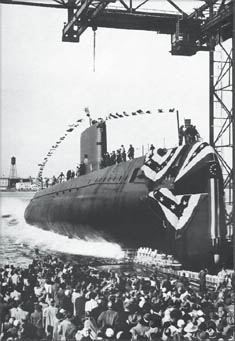| Our Submarine
History Page 2 || Nuclear Navy Aricle Copy
Navy Marks Birth Of The Nuclear Sub Nautilus Launched 50 Years Ago By ROBERT A. HAMILTON b.hamilton@theday.com Article copied from The Day Published on 1/22/2004
Ratte said that as the Nautilus slid down the building ways at Electric Boat, it ushered in a new era of naval propulsion in which submarines were equipped to make their own air, water and power without surfacing. Nautilus eventually would make 2,500 dives and steam more than 510,000 miles. As he stood in the Submarine Force Library and Museum with the Historic Ship Nautilus as his backdrop, Ratte said the submarine force has not rested on its laurels. ?In its day, compared to the seemingly quenchless diesel boats, Nautilus would travel an amazing two years without refueling,? Ratte said. ?We look forward to a similar leap, as tomorrow's fast-attack submarines will travel their entire life, an anticipated 33 years, without refueling.? Retired Rear Adm. Millard Firebaugh, now the chief engineer and vice president for innovation at EB, noted that the company will commission the USS Virginia this summer, which will ?redefine the state-of-the-art in submarine capability, with numerous advanced technologies onboard and operational. ?These will include lightweight wide-aperture (sonar) arrays, advanced electronic support measures, non-hull-penetrating photonics masts, an advanced electromagnetic silencing system and mine detection and avoidance systems,? Firebaugh said. ?Real-time links to offboard underwater, surface, air and space-based assets will give the ship unprecedented communications capabilities to participate in network-centric warfare,? he said. EB continues to explore concepts to increase submarine payload, improve its silencing and ability to detect enemies and enable it to operate a range of auxiliary vehicles. And it all began with SSN 571, the Nautilus, now secured to a pier at the museum, which about 250,000 people a year visit. ?No short speech, nor long, nor shelf of books can begin to capture the reality of the program for which this great ship was the trailblazer,? Firebaugh said. Nautilus went from an idea to a christened ship in just six years, with a ceremony on Jan. 21, 1954. Some 15,000 people watched first lady Mamie Eisenhower smash a bottle of champagne against the hull. The museum plans a series of observances over the next year, including special events and exhibits, lectures by former Nautilus crewmen and commanding officers and a celebration of the ship's 1983 designation as the official Connecticut state ship. The big event will be the Sept. 30 celebration of the 50th anniversary of the commissioning ceremony, and the submarine's ?golden year? will conclude with special events Jan. 17, 2005, which will mark 50 years since the submarine backed away from the pier and Cmdr. Eugene P. Wilkinson sent the historic message, ?Underway on nuclear power.? Wednesday's ceremony was planned as a small local event, but more than 100 people crammed into the exhibit hall for it, including 10 people who were at the launch a half-century ago. One of them was David A. Phoenix of Woodstock, who was an engineman first class. ?It was great,? Phoenix said. ?It was all unknown, and it was a thrill a minute — we were all learning something new, doing things that nobody had ever done before. It was like going to the moon, that kind of adventure.? Phoenix's wife, Catherine, received a bouquet of red roses and a bottle of champagne to mark her participation in the ceremony in 1954. Groton City Mayor Dennis Popp, who helped build Los Angeles-class submarines for 30 years at EB, said local people who are old enough recall the parade that welcomed the Nautilus home from its historic voyage under the North Pole in 1958, smaller but no less enthusiastic than the tickertape parade the crew got in New York City. He said he was proud to be able to say Nautilus was ?bred here, born here, and came back to rest here where many, many people can visit her.? Groton Town Mayor Harry Watson Jr. said Nautilus is probably the town's most prominent claim to fame, because history will always record that the era of naval nuclear propulsion began in Groton during the 1950s. Ratte noted that although Nautilus was a technological marvel, shattering all speed and endurance records and bringing an unprecedented level of stealth to undersea warfare, it was still just a machine. ?Just as it was 50 years ago today when Nautilus was launched, the true strength of our great nation and Navy lays in our young sailors, America's finest, those on deployments yesterday and today and those who will answer the call to service tomorrow,? Ratte said. ?They follow and carry forward an extraordinary legacy of initiative, vigor and expectation, a legacy fashioned and forged by selfless service and sacrifice, like that of all those who conceived of, designed, built and crewed the submarine we celebrate today — USS Nautilus, the world's first nuclear-powered ship.? © The Day Publishing Co., 2004 |
 Groton
— With the launch of the Nautilus here 50 years ago Wednesday, the United
States leaped into the atomic age, Navy Capt. James E. Ratte Jr., commanding
officer of the Naval Submarine Base, said during a commemoration ceremony.
Groton
— With the launch of the Nautilus here 50 years ago Wednesday, the United
States leaped into the atomic age, Navy Capt. James E. Ratte Jr., commanding
officer of the Naval Submarine Base, said during a commemoration ceremony.